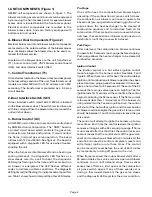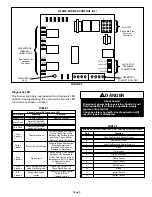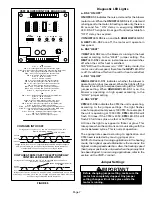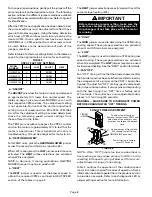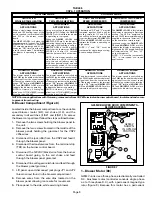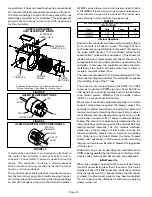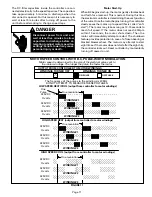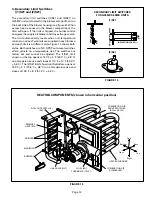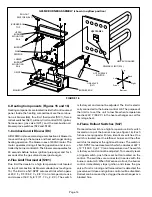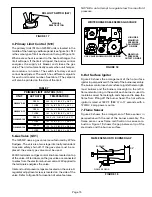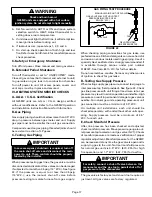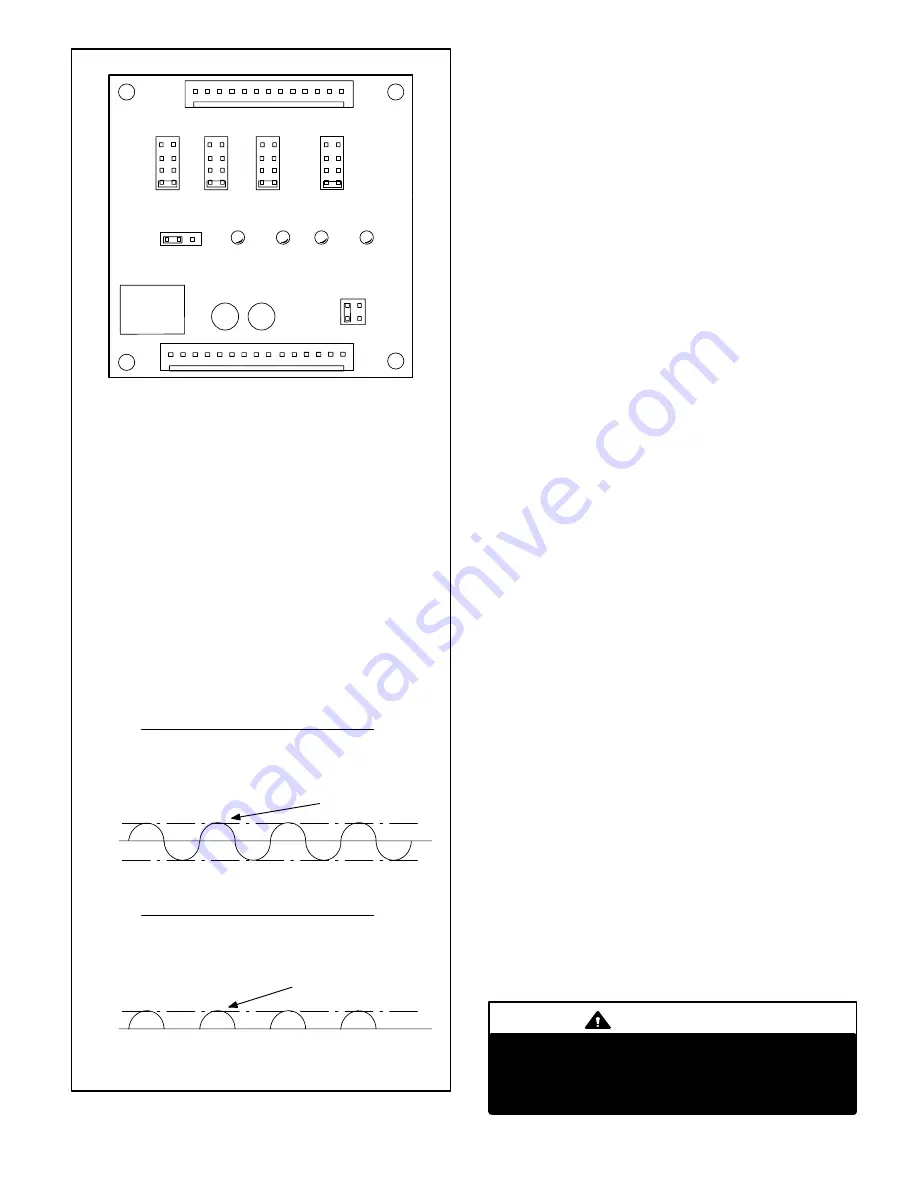
Page 7
FIGURE 5
VSP2 BLOWER CONTROL BOARD (A24)
VOLTAGES INTO VSP2
VOLTAGES FROM VSP2 TO ELECTRONICALLY
CONTROLLED BLOWER MOTOR
34 volts
–34 volts
0 volts
Voltage across J73 pins 13 to 1 and 6 to 1 is 24VAC as shown here.
Refer to unit wiring diagram.
Voltage across J46 pins 6 to 3 and 1 to 3 is half-rectified AC as shown here.
Refer to unit wiring diagram.
Voltage across J73 pins 4 to 1 is approximately 15-20VDC (straight voltage) if
CCB is used. If Harmony is used a voltage of 0–25VDC should be present.
If CCB or Harmony is not used, pin 4 to 1 voltage is 21VAC.
Approx.
34 volts
0 volts
Voltage across J46 pins 8 and 9 to 3, is approximately 15-20VDC if CCB is used. If CCB
or Harmony is not used, pins 8 and 9 to 3 voltage is approximately 21VAC. If Harmony
is used a voltage of 0–25VDC should be present.
24VAC @ 60Hz.
24VAC Half-Rectified (DC Pulse)
@ 60Hz.
J46
HIGH
LOW
ADJUST
HEAT
CFM
HI/LOW
ON/OFF
HEAT
HTG.
BLOWER
1
2
DS2
DS3
DS1
DS4
1
2
3
4
1
2
3
4
1
2
3
4
TEST
–
+
NORM
210
150
90
270
J73
1
1
J73
PIN 1 - C - 24 VAC common.
PIN 2 - G - Input signal from thermostat’s fan signal.
PIN 3 - W2 - Input signal for second stage heat from the thermostat.
PIN 4 - DS - Input signal for the blower speed regulation.
PIN 5 - Limit - Input signal from the external limit.
PIN 6 - R - 24 VAC power to the thermostat.
PIN 7 - C - 24 VAC common.
Pin 8 - C - 24 VAC common.
PIN 9 - CI - Input signal from the fan limit control.
PIN 10 - CO - Output signal to the burner control.
PIN 11 - HT - Input signal from the fan limit control.
PIN 12 - ACC - 24 VAC accessory output.
PIN 13 - 24V - Input 24 VAC power for the VSP2-1.
PIN 14 - 24V - Input 24 VAC power for the VSP2-1.
PIN 15 - V - Input signal from the gas line.
J46
PIN 1 - Heat - Heat speed input signal to the ICM2 motor.
PIN 2 - C - 24 VAC common.
PIN 3 - C - 24 VAC common.
PIN 4 - High Tap - High Speed programming input.
PIN 5 - Low Tap - Low speed programming input.
PIN 6 - On / Off - On / off output signal to the ICM2 motor.
PIN 7 - Adjust Tap - ICM2 mode selection.
PIN 8 - Hi / Low - Speed regulate input signal to the ICM2 motor.
PIN 9 - Hi / Low - Speed regulate input signal to the ICM2 motor.
PIN 10 - Ref. V - ICM2 reference voltage.
PIN 11 - Heat Tap - Heating blower speed programming.
PIN 12 - C - 24 VAC common.
PIN 13 - cfm - Motor speed diagnostic signal.
Diagnostic LED Lights
ON/OFF
–DS3 indicates there is a demand for the blower
motor to run. When the
ON/OFF
LED–DS3 is lit, a demand
is being sent to the motor. In heating mode only, there is a
45 second fan “ON” delay in energizing
ON/OFF
LED–DS3. The light will not go off until adjustable fan
“OFF” delay has expired.
If
ON/OFF
LED–DS3 is on and both
HIGH/LOW
LED–DS1
&
HEAT
LED–DS2 are off, the motor will operate in
low speed.
If
HEAT
LED–DS2 is on, the blower is running in the heat
speed according to the “HEAT” jumper setting. The
HEAT
LED–DS2 comes on instantaneous and switches
off when the call for heat is satisfied.
NOTE–When the blower is in “OFF” delay mode, the
motor runs at low speed, therefore the
HEAT
LED–DS2
is off. It switches off when the call for heat is satisfied.
HIGH/LOW
LED–DS1 indicates whether the blower is
operating in high or low speed. When the light is off, the
blower is running in low speed according to the “LOW”
jumper setting. When
HIGH/LOW
LED–DS1 is on, the
blower is operating in high speed according to the
“HIGH” jumper setting.
CFM
LED–DS4 indicates the CFM the unit is operating,
according to the jumper settings. The light flashes
once for approximately every 100 CFM. For example, if
the unit is operating at 1000 CFM,
CFM
LED–DS4 will
flash 10 times. If the CFM is 2050,
CFM
LED–DS4 will
flash 20 full times plus one fast or half flash.
At times the light may appear to flicker or glow. This
takes place when the control is communicating with the
motor between cycles. This is normal operation.
The appropriate speed according to application and
CFM need is selected by moving jumper pins.
NOTE–On Harmony II zoning applications in the heating
mode, the highest speed obtainable is the same as the
highest cooling speed selection. Also, the heating speed
(heat jumper position) is only used when the primary limit
has been tripped. In non–zoning applications, refer to the
section on the VSP2–1 control.
Jumper Settings
IMPORTANT
Before changing jumper setting, make sure the
motor has completely stopped. Any jumper
setting change will not take place while the
motor is running.




